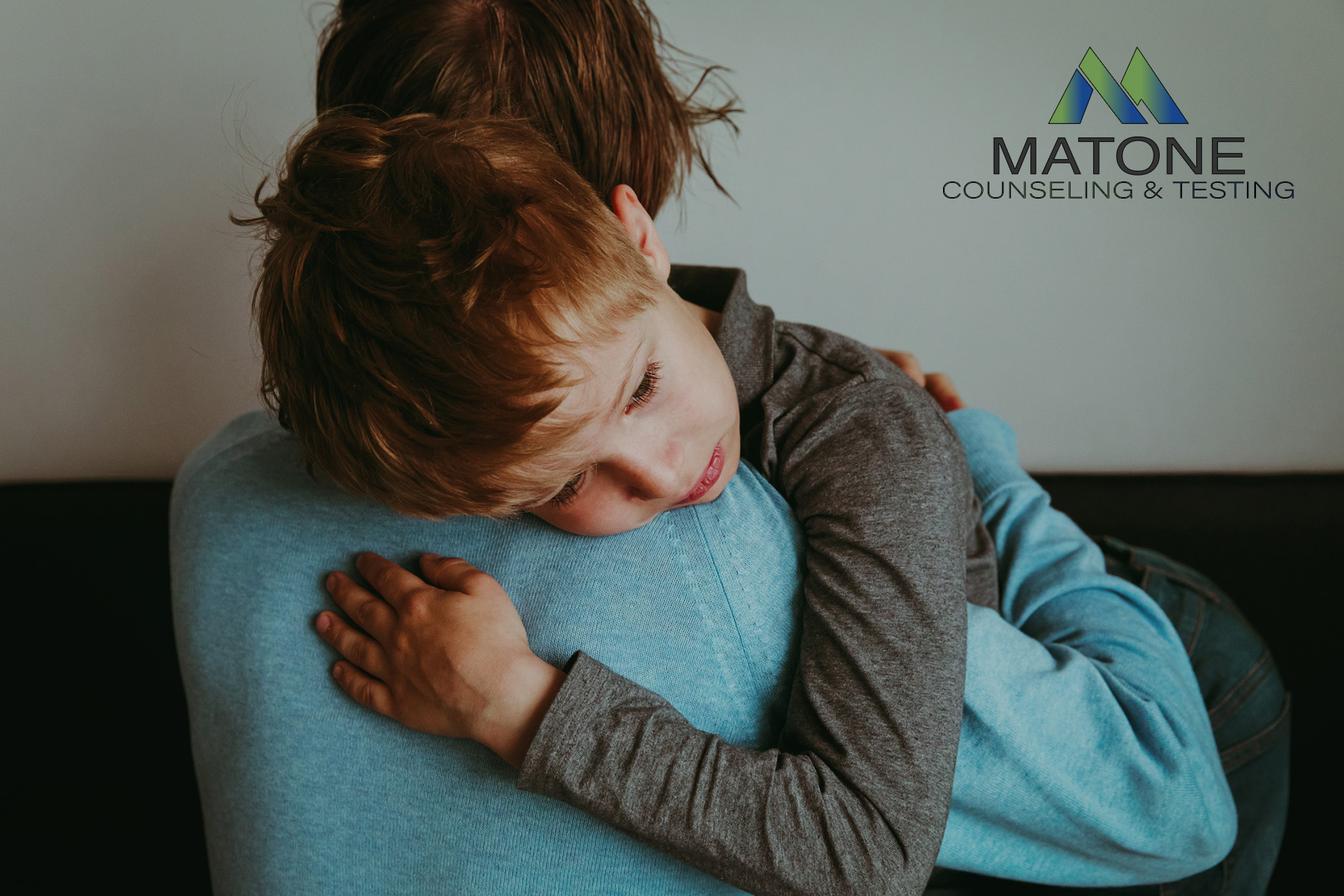Grief and Loss for Children
Definition of Grief
Generally, grief is defined as a primarily emotional (affective) reaction to loss and the “usual reaction to bereavement [i.e., intense distress] and incorporates diverse psychological (cognitive, social-behavioral) and physical (physiological-somatic) manifestations” (Stroebe et al., 2001, p. 6) and is often understood in the context of the loss of someone. However, grief can be experienced in the context of many types of loss which are all valid and impactful. The experience of grief following loss is a universal, natural, and normal reaction, varying in duration, intensity, longevity, and symptomology for everyone (Archer, 1999). Feelings and emotions experienced from loss can be intense and frightening (Walker & Shaffer, 2007). One does not have to understand grief and loss to be able to feel the impact (Dyregrov (2008). Grief is multifaceted and multi-dimensional.
Different Types of Loss
- Loss of a pet
- Loss of parents or caregiver
- Separation or divorce
- Moving
- Incarceration of a friend or family member
- Sickness of a friend or family member
- Loss of a job
- Loss of a relationship or friendship
- Loss of ableness
- Long-term (e.g., terminal illness/cancer)
- Unexpected, immediate death (e.g., heart failure)
- Natural cause of death (e.g., heart failure)
- Unnatural cause of death (e.g., natural disaster, murder)
“Grief is as individual as a fingerprint” so that many define, feel, understand, and experience grief in their own unique way (Hankes, p. 237).
Some of the factors that can make the experience of grief unique to an individual include:
- Age
- Developmental stage
- Cognitive-processing ability
- Temperament
- Access to coping and adjustment resources
- Past experience with loss
- Quality and number of supportive relationships
- Family issues such as incongruence, interpersonal discord, emotional unavailability from caregivers, instability
Statistical Prevalence
According to the US Census Bureau, approximately 1.5 million children live in a single-parent home due to the death of one parent (as cited in Owens, 2008). A study conducted in Britain found that 5% of children and adolescents had experienced the death of a mother or a father by the time they turned 16 years of age (Parsons, 2011). Nearly 8% of the population may experience the death of a sibling before the age of 25 (Fletcher, Mailick, Song, & Wolfe, 2013). Out of a sample of 11-16 year old adolescents in England, 77.6% indicated that they had recently lost a close relative or a close friend (Harrison & Harrington, 2001). Over 2 million children in the U.S. are impacted directly by parent’s service in the military during deployment to both Afghanistan and Iraq with 40% being under the age of 5 (Military Community and Family Policy, 2005). 2.3% of the estimated 74 million U.S. children under the age of 18 had a parent in prison (Glaze & Maruschak, 2008).
Grief and Loss for Children
The grief process is different for children than it is for adults (Malone, 2010). Yet, most conceptualizations of the grief process are viewed through an adult lens and research has relied heavily on adult descriptions of behaviors and emotional manifestations. While many resources exist for grieving adults, little is available for children and adolescents, and children often find themselves grieving alone and with minimal support (Pataky & Parent, 2018; Walker & Shaffer, 2007).
Developmental Factors
Grief varies in duration, intensity, and symptomology in each stage of development (Green & Connolly, 2009). As children move through the life span, they may reprocess, resolve, and integrate loss in a new and different ways (Turner, 2020). Counselors need to remember that “children and adolescents are not always cognizant of the impact of death as it relates to their own fears, suppression of feelings, and finality” (Dickens, 2014, p. 119). In fact, once children reach the age of six, they are able to express more intense sadness, anger, and upset emotions, given that they understand the irreversibility of death (Christ, 2000). However, most children still lack the verbal and abstract reasoning skills to capture the complexity of loss and grief, struggle to connect and express their emotions and feelings (Webb, 2011), and may turn to behaviors or somatic ways of expressing how they are feeling which can lead to some of the following:
Physical Factors
- Headaches
- Sleep disturbances
- Muscle pain and tension
- Stomachaches
- Eating disturbances
- Joint pain
- Being ill more often
Social Factors
- Feeling different from peers
- Social isolation
- Perception of peers being intolerant of their grief
- Isolation from family
- Risk-taking behavior
- Increased sense of maturity
- Avoidance of reminders
- Antisocial
- Withdrawn from normal activities
- Change in peer group
- Self-destructive behavior
Emotional Factors
- Dazed
- Numb
- Shocked
- Afraid
- Frustrated
- Alone
- Anxious
- Guilty
- Uncomfortable when happy
- Sad
- Irritable
- Vulnerable
- Angry
- Aggressive
Cognitive Factors
- Decline in school performance
- Paranormal experiences
- Preoccupations
- Thoughts of own death
- Realization of permanence of death
- Disbelief
- Sense of presence of the deceased
- Distracted
- Confusion
- Difficulty concentrating
- Intrusive thoughts
- Lowered self-esteem
- Memory problems
Multicultural Implications
An additional important way clinicians and parents can support and help children process loss and grief as they move through the grief and loss process is to increase knowledge and awareness of cultural differences in grieving. We must understand how individual cultures, traditions, religious/spiritual beliefs, and communities impact the ways in which children grieve.
Tips for Parents
Since the experience of grief following loss is unique to everyone, is multifaceted and multi-dimensional, varying in duration, intensity, longevity, and symptomology, and feelings and emotions experienced from loss can be intense and frightening for both parents and children it can be difficult knowing how to support children through their grieving process. We have included some tips that may help:
- Grief is a natural human experience, not a problem
- Healing is not about letting go, but instead ways to preserve and treasure the relationship
- Grief is a process and not a specific emotion
- Trace misunderstandings, misconceptions, and magical thinking.
- Use the deceased person’s name
- Avoid hiding own feelings of grief from a child
- Get support
- Talk about how the body works, and how living bodies are different from dead bodies.
- Avoid saying things like “Don’t cry. You need to be strong” or “You’re the man in the family now” or “Be a good girl. Your mommy needs your help now more than ever”
- Just Listen
- Allow children to express their grief in their own way and time.
- Let the child tell their story and normalize the feelings they have
- Understand children may not be able to verbalize what they are feeling
- Help the child find their personal meaning and understanding of the event
- Encourage them to express their thoughts and questions
- Emphasize openness and honesty in the home
- Reassure children it is okay to talk about death and grief
- Expect children to have “grief bursts” followed by play and normal activities.
- Accept their reactions or lack of reaction.
- Give them an immediate sense of being taken care of
- Do not to pressure children to resume their normal activities if they are not ready
- Children are often most comforted by familiar surroundings and routines
- Separation may increase their fears about abandonment
Types of Treatment
It is important for counselors to listen to children’s stories with non-threatening approaches to the treatment process that are sensitive to children’s lack of verbal and abstract reasoning skills to capture the complexity of loss and grief and their struggle to connect and express their emotions and feelings (Webb, 2011). Counselors must also be sensitive to the neurodiversity of grieving children and might need to utilize creative techniques and interventions to help children work through and give appropriate meaning to their experience of loss (Stutey, et al., 2016). Additionally, treatment for children needs to be ongoing following a significant loss to help them process overwhelming and complicated emotions.
- Bereavement Camps are a helpful part of grief treatment process in that they help to normalize the grief experience; help children develop confidence and self-esteem; help develop teamwork strategies; provides an opportunity to process grief in a safe and supported environment; develops connections with other participants (other children and camp staff), memorializes their loved one, helped foster resiliency and showed potential for growth to rise out of painful experience; as well as learn coping skills they can utilize at home.
- Creative and Play Therapy is one intervention for children to help them process grief and promote healing; it can provide a safe environment for children to express emotions and develop an understanding for their feelings. Modify according to children’s ages, circumstances, and settings. When planning interventions consider child’s age and developmental stage. Some examples can include, creating rituals (e.g., balloon launching), writing letters. comfort pillows, creating a collage or memory box. Provide prompts for art, journaling, or discussion: one of my sweetest memories is of; I think of you whenever I hear; I am reminded of you when I smell; I feel sad when; My happiest day was when; I will never forget; If I could talk to you one more time; If I could change; I am sorry that.
- Sandtray Therapy is therapeutic for children; play and artwork is child-directive, unconscious reenactment that can be sled-soothing and offer nonthreatening, imaginative, metaphoric, and symbolic approaches to telling a story, both verbally and nonverbally; provides an often necessary therapeutic distance from painful memories and traumatic events; opportunity to express loss, say “goodbye,” remember, reflect, and reintegrate; allow for continued grief as it changes over time; and feel anchored as the loss can be made tangible. Some sandtray prompts can include: What’s something that happened at school this week? What is it like when you’re at your house? Use the miniatures to show how you feel right now; Set up various scenes of the before, during, and after phases of loss; Create a vision board that expresses wants, hopes, and goals; Create a scene you want to show or tell the lost person.
- Group Therapy can provide additional effective treatment opportunities: children can share experiences with others who have similar stories; feel less different; have feelings validated; and through play and art, can engage with others without talking.
Books for Children Processing Grief
- Tear Soup: A Recipe for Healing After Loss
- The Next Place
- The Invisible String
- Nana Upstairs, Nana Downstairs
- The Goodbye Book
- Someone I Love Died
- The Memory Box
- Grief is Like a Snowflake
- Why Do I Feel So Sad
- Ida, Always
Finding mental health counseling for loss and grief can be difficult. Fortunately, Matone Counseling & Testing can offer mental health services from providers with experience navigating therapy with children facing loss and grief. Feel free to reach out and schedule an appointment!

Written by: Shannon Marshall
Shannon Marshall is a graduate student in the Master of Arts Clinical Mental Health Counseling program at Northwestern University. She is completing her last quarter and Internship requirement at Matone Counseling and Testing. Before transitioning to a career in counseling, Shannon completed a Bachelor of Arts in Psychology from The George Washington University and some additional training in Marriage and Family Therapy at the University of New Hampshire. Shannon has spent time assisting Dr. Sonya Lorelle at Northwestern University with research projects focusing on trauma, loss, grief, and play therapy. Shannon is passionate about working with children and teens who may be experiencing loss and grief.
References
Archer, J. (1999). The Nature of Grief: The Evolution and Psychology of Reactions to Loss.
New York, NY: Routledge.
Bassuk, E. L., DeCandia, C. J., Beach, C. A. & Berman, F. (2014). America’s Youngest Outcasts: A
Report Card on Child Homelessness. Waltham, MA: The National Center on Family Homelessness at American Institutes for Research.
Dickens, N. (2014). Prevalence of complicated grief and posttraumatic stress disorder in
children and adolescents following sibling death. The Family Journal: Counseling and Therapy for Couples and Families, 22(1), 119-126. doi: DOI: 10.1177/1066480713505066 tfj.sagepub.com
Dyregrov, A. (2008). Grief in Children: A Handbook for Adults Second Edition. London: Jessica
Kingsley Publishers.
Fletcher, J., Mailick, M., Song, J. & Wolfe, B. (2013). A sibling death in the family: Common and
consequential. Demography, 50, 803-826. doi: 10.1007/s13524-012-0162-4
Glaze, L. E. & Maruschak, L. M. (2008). Parents in prison and their minor children. Bureau of
Justice Statistics Special Report. U.S. Department of Justice Office of Justice Programs.
Glazer, H.R. (2010). Play Therapy for Preschool Children. Filial play therapy for grieving preschool children Chapter 5. American Psychological Association, pp. 89-104.
Green, E.J., & Connolly, M.E. (2009). Jungian family sandplay with bereaved children:
Implications for play therapists. International Journal of Play Therapy, 18(2), 84-98.
Harrison, L. & Harrington, R. (2001). Adolescents’ bereavement experiences. Prevalence,
associated with depressive symptoms, and use of services. Journal of Adolescents, 24, 159-
- doi:10.1006/jado.2001.0379
Hillis, S. D., Blenkinsop, A., Villaveces, A., Annor, F. B., Liburd, L., Massetti, G. M., Demissie, Z.,
Mercy, J.A., Nelson III, C. A., Cluver, L., Flaxman, S., Sherr, L., Donnelly, C. A., Ratmann, O., Unwin; H.J., (2021). COVID–19–associated orphanhood and caregiver death in the United States. Pediatrics, 148 (6), 1-13, https://doi.org/10.1542/peds.2021-053760
Humphrey, K. M. (2009). Counseling strategies for loss and grief. Alexandria, VA: American
Counseling Association.
Kreider, R. M & Ellis, R. (2011). Living arrangements of children: 2009. Current Population
Reports, 70-126. U.S. Census Bureau, Washington, DC, 2011.
https://www.census.gov/prod/2011pubs/p70-126.pdf
Malone, P. A. (2007). The impact of peer death on adolescent girls: A task-oriented group
intervention. Journal of Social Work in End-of-Life & Palliative Care, 3(3), 23-37.
Office of the Deputy Under Secretary of Defense (Military Community and Family Policy) . 2005 Demographics Profile of the Military Community. Washington, DC: Office of the Deputy Under Secretary of Defense; 2005.
Oltjenbruns, K. A. (2001). Developmental context of childhood: Grief and regrief phenomena
In M. S. Stroebe, R. O. Hansson, W. Stroebe & H. Schut (Eds.)., Handbook of Bereavement Research: Consequences, Coping and Care (p.169-197). Washington, US: American Psychological Association.
Owens, D. A. (2008). Recognizing the needs of bereaved children in palliative care. Journal of
Hospice and Palliative Nursing, 10(1), 14-16.
Parson, S. (2011). Long-term impact of childhood bereavement: Preliminary analysis of the
1970 British Cohort Study (BCS70).
Pataky, M. G., & Parent, K. T. (2018). Ambiguous loss in schools: Guidelines for
practitioners. School Social Work Journal, 43(1), 1-19.
Sorensen, J., & Ahmad, M. (2008). Overcoming Loss: Activities and Stories to Help Transform
Children’s Grief and Loss. London: Jessica Kingsley Publishers.
Stroebe, M. S., Hasson, R. O., Strobe, W., & Schut, H. (2001). Introduction: Concepts and Issues
in Contemporary Research on Bereavement. In M. S.
Stroebe, R. O. Hansson, W. Stroebe & H. Schut (Eds.)., Handbook of Bereavement Research:
Consequences, Coping and Care (p.3-22). Washington, US: American Psychological Association.
Stutey, D.M., Helm, H.M., LoSasso, H., & Kreider, H.D. (2016). Play therapy and photo-
elicitation: A narrative examination of children’s grief. International Journal of Play Therapy, 25(3), 154-165. http://dx.dol.org/10.1037/a0039956
Turner, R. (2020). Playing through the unimaginable: Play therapy for traumatic loss. American
Psychological Association, 29(2), 96-101. Vistas Healthcare. (n.d.). Guidelines for helping grieving children.
Walker, P. & Shaffer, M. (2007). Reducing depression among adolescents dealing with grief and
loss: a program evaluation report. Health and Social Work, 32(1). 67-68.




